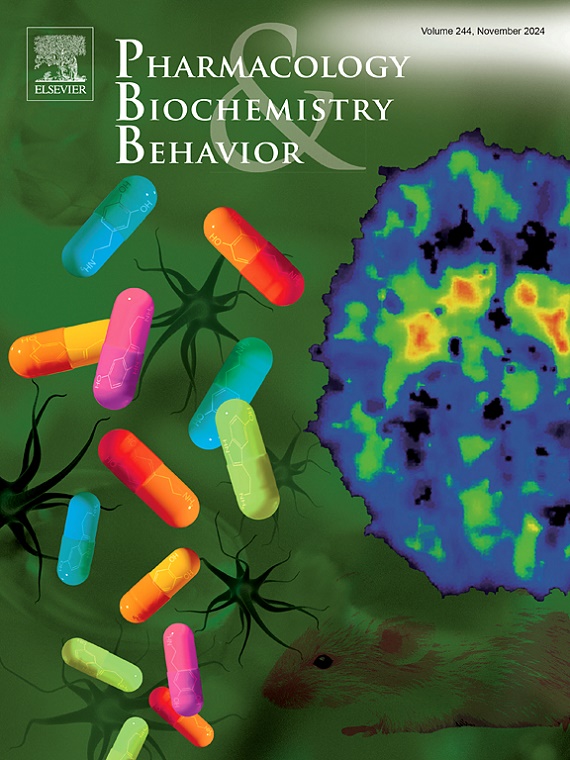操作性努力决策任务揭示了青春期间歇乙醇对Sprague Dawley大鼠动机行为的性别差异,但没有长期影响
IF 3.3
3区 心理学
Q1 BEHAVIORAL SCIENCES
引用次数: 0
摘要
动机行为的丧失,或冷漠,是多种情感障碍的一个关键特征,并通过操作性努力决策(EBDM)进行评估。动机机制与促炎信号直接影响多巴胺信号有关。慢性酒精暴露与免疫信号改变和目标导向行为受损有关,因此本研究评估了青少年间歇性酒精(AIE)对成年期EBDM的影响。在出生后~30 ~ 50天或给药期间,按3天开/停2天的时间,将青春期雄性和雌性sd大鼠(N = 32/ N = 8 /组)灌胃酒精(4 g/kg),直至成年(P80+)。然后对所有大鼠进行操作性EBDM并发FR5/chow任务训练,之后我们测试了性别和AIE史对反应的影响:1)在以log2模式提高FR需求的breakpoint刺激期间,2)免疫刺激(2 μg/kg IL-1β)后90分钟,3)3.5 g/kg腹腔内乙醇刺激(宿醉)后18小时,4)在限制性应激刺激30分钟后立即。免疫挑战破坏了动机行为,但不影响食欲。AIE没有产生任何影响,性别差异在所有挑战中都很明显。雌性对颗粒的反应较少,但持续反应,直到更高的断点。这项工作表明,AIE不会改变基线或诱发EBDM,可以用这种方法测量。应该进行跨年龄和使用其他方式的测试,以继续检查慢性酒精对冷漠的影响。本文章由计算机程序翻译,如有差异,请以英文原文为准。
Operant effort-based decision-making task reveals sex differences in motivational behavior but no long-term effects of adolescent intermittent ethanol in Sprague Dawley rats
Loss of motivated behavior, or apathy, is a key feature across multiple affective disorders, and is assessed via operant effort-based decision-making (EBDM). The mechanisms of amotivation have been connected to pro-inflammatory signaling which can directly impact dopamine signaling. Chronic alcohol exposure is associated with altered immune signaling and impaired goal-directed behavior, so the present studies assessed the impact of adolescent intermittent ethanol (AIE) on EBDM in adulthood across sex. Adolescent male and female (N = 32/n = 8 per group) Sprague-Dawley rats were exposed to ethanol (4 g/kg) intragastrically on a 3 days on/2 days off schedule during postnatal days ~30–50 or given vehicle, and allowed to age into adulthood (P80+). All rats were then trained on the operant EBDM concurrent FR5/chow task, after which we tested the impact of sex and AIE history on responding 1) during breakpoint challenge raising the FR requirement in a log2 pattern, 2) 90 min after immune challenge (2 μg/kg IL-1β), 3) 18 h after 3.5 g/kg intraperitoneal ethanol challenge (hangover), and 4) immediately after a 30-min restraint stress challenge. Immune challenge disrupted motivated behavior without affecting appetite. No effects of AIE emerged and sex differences were evident throughout all challenges. Females responded less for pellets yet persisted responding until a higher breakpoint. This work indicates that AIE does not alter baseline or evoked EBDM as can be measured with this approach. Testing across aging and using other modalities should be performed to continue examining the effects of chronic alcohol on apathy.
求助全文
通过发布文献求助,成功后即可免费获取论文全文。
去求助
来源期刊
CiteScore
6.40
自引率
2.80%
发文量
122
审稿时长
38 days
期刊介绍:
Pharmacology Biochemistry & Behavior publishes original reports in the areas of pharmacology and biochemistry in which the primary emphasis and theoretical context are behavioral. Contributions may involve clinical, preclinical, or basic research. Purely biochemical or toxicology studies will not be published. Papers describing the behavioral effects of novel drugs in models of psychiatric, neurological and cognitive disorders, and central pain must include a positive control unless the paper is on a disease where such a drug is not available yet. Papers focusing on physiological processes (e.g., peripheral pain mechanisms, body temperature regulation, seizure activity) are not accepted as we would like to retain the focus of Pharmacology Biochemistry & Behavior on behavior and its interaction with the biochemistry and neurochemistry of the central nervous system. Papers describing the effects of plant materials are generally not considered, unless the active ingredients are studied, the extraction method is well described, the doses tested are known, and clear and definite experimental evidence on the mechanism of action of the active ingredients is provided.

 求助内容:
求助内容: 应助结果提醒方式:
应助结果提醒方式:


